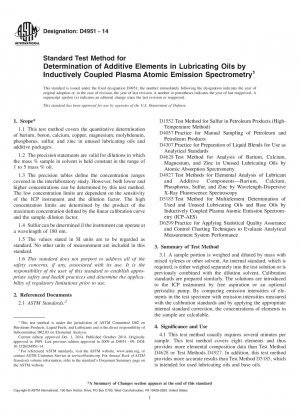ASTM D4951-14
Standard Test Method for Determination of Additive Elements in Lubricating Oils by Inductively Coupled Plasma Atomic Emission Spectrometry
- Standard No.
- ASTM D4951-14
- Release Date
- 2014
- Published By
- American Society for Testing and Materials (ASTM)
- Status
- Replace By
- ASTM D4951-14(2019)
- Latest
- ASTM D4951-14(2019)
- Scope
4.1 This test method usually requires several minutes per sample. This test method covers eight elements and thus provides more elemental composition data than Test Method D4628 or Test Methods D4927. In addition, this test method provides more accurate results than Test Method D5185, which is intended for used lubricating oils and base oils.
4.2 Additive packages are blends of individual additives, which can act as detergents, antioxidants, antiwear agents, and so forth. Many additives contain one or more elements covered by this test method. Additive package specifications are based, in part, on elemental composition. Lubricating oils are typically blends of additive packages, and their specifications are also determined, in part, by elemental composition. This test method can be used to determine if additive packages and unused lubricating oils meet specifications with respect to elemental composition.
4.3 Several additive elements and their compounds are added to the lubricating oils to give beneficial performance (Table 1).
1.1 This test method covers the quantitative determination of barium, boron, calcium, copper, magnesium, molybdenum, phosphorus, sulfur, and zinc in unused lubricating oils and additive packages.
1.2 The precision statements are valid for dilutions in which the mass % sample in solvent is held constant in the range of 1 to 5 mass % oil.
1.3 The precision tables define the concentration ranges covered in the interlaboratory study. However, both lower and higher concentrations can be determined by this test method. The low concentration limits are dependent on the sensitivity of the ICP instrument and the dilution factor. The high concentration limits are determined by the product of the maximum concentration defined by the linear calibration curve and the sample dilution factor.
1.4 Sulfur can be determined if the instrument can operate at a wavelength of 180 nm.
1.5 The values stated in SI units are to be regarded as standard. No other units of measurement are included in this standard.
1.6 This standard does not purport to address all of the safety concerns, if any, associated with its use. It is the responsibility of the user of this standard to establish appropriate safety and health practices and determine the applicability of regulatory limitations prior to use.
ASTM D4951-14 Referenced Document
- ASTM D1552 Standard Test Method for Sulfur in Petroleum Products (High-Temperature Method)
- ASTM D4057 Standard Practice for Manual Sampling of Petroleum and Petroleum Products
- ASTM D4307 Standard Practice for Preparation of Liquid Blends for Use as Analytical Standards
- ASTM D4628 Standard Test Method for Analysis of Barium, Calcium, Magnesium, and Zinc In Unused Lubricating Oils By Atomic Absorption Spectrometry
- ASTM D4927 Standard Test Methods for Elemental Analysis of Lubricant and Additive Components8212;Barium, Calcium, Phosphorus, Sulfur, and Zinc by Wavelength-Dispersive X-Ray Fluorescence Spectroscopy
- ASTM D5185 Standard Test Method for Determination of Additive Elements, Wear Metals, and Contaminants in Used Lubricating Oils and Determination of Selected Elements in Base Oils by Inductively Coupled Plasma Atomic Emission Spectrometry (ICP-AES)
- ASTM D6299 Standard Practice for Applying Statistical Quality Assurance and Control Charting Techniques to Evaluate Analytical Measurement System Performance
ASTM D4951-14 history
- 2019 ASTM D4951-14(2019) Standard Test Method for Determination of Additive Elements in Lubricating Oils by Inductively Coupled Plasma Atomic Emission Spectrometry
- 2014 ASTM D4951-14 Standard Test Method for Determination of Additive Elements in Lubricating Oils by Inductively Coupled Plasma Atomic Emission Spectrometry
- 2009 ASTM D4951-09 Standard Test Method for Determination of Additive Elements in Lubricating Oils by Inductively Coupled Plasma Atomic Emission Spectrometry
- 2006 ASTM D4951-06 Standard Test Method for Determination of Additive Elements in Lubricating Oils by Inductively Coupled Plasma Atomic Emission Spectrometry
- 2002 ASTM D4951-02 Standard Test Method for Determination of Additive Elements in Lubricating Oils by Inductively Coupled Plasma Atomic Emission Spectrometry
- 2000 ASTM D4951-00 Standard Test Method for Determination of Additive Elements in Lubricating Oils by Inductively Coupled Plasma Atomic Emission Spectrometry
